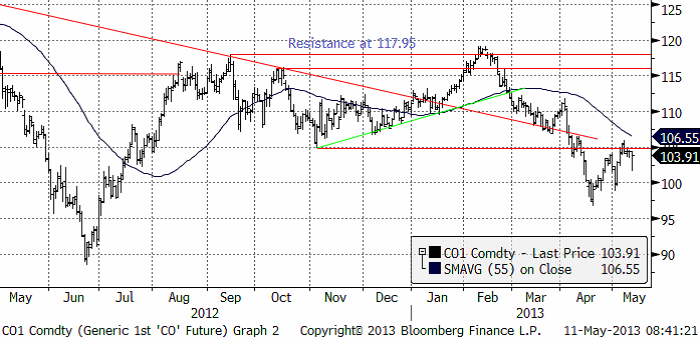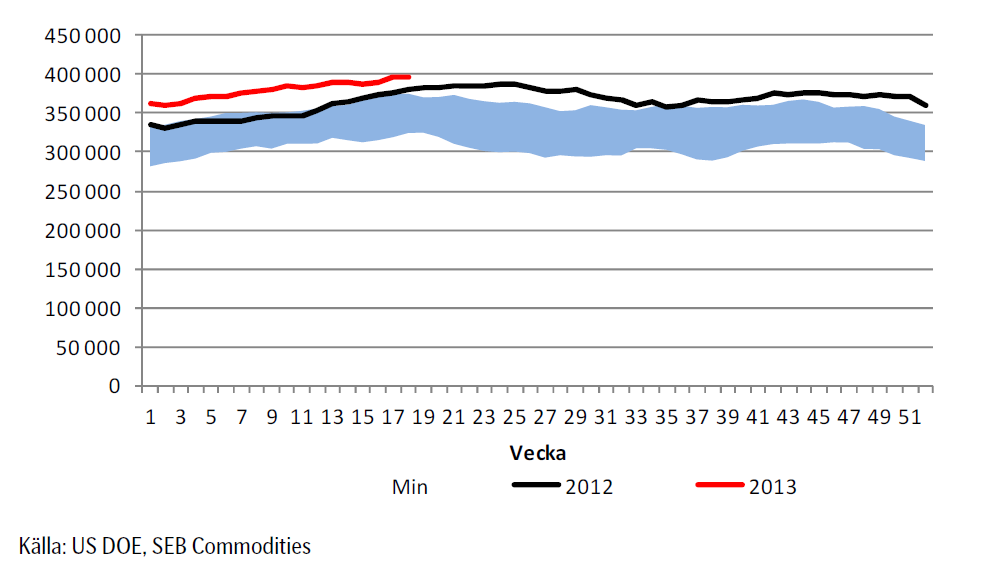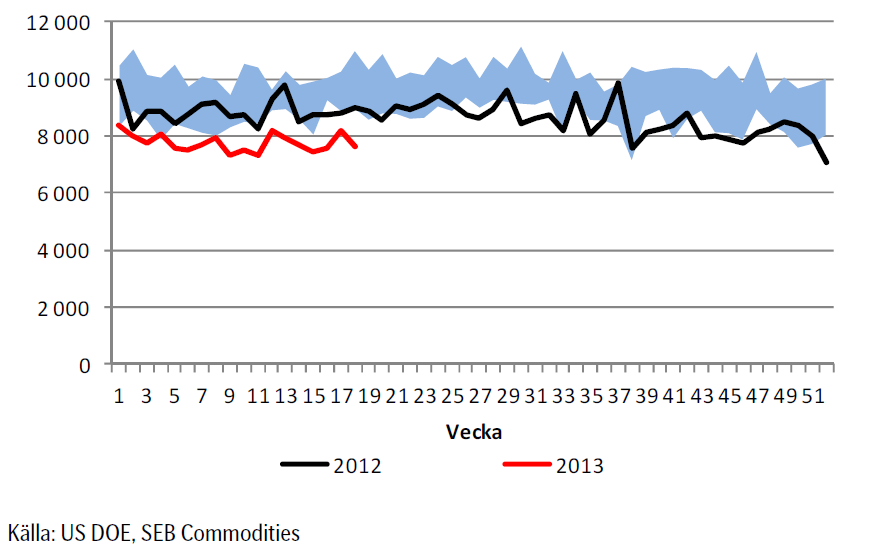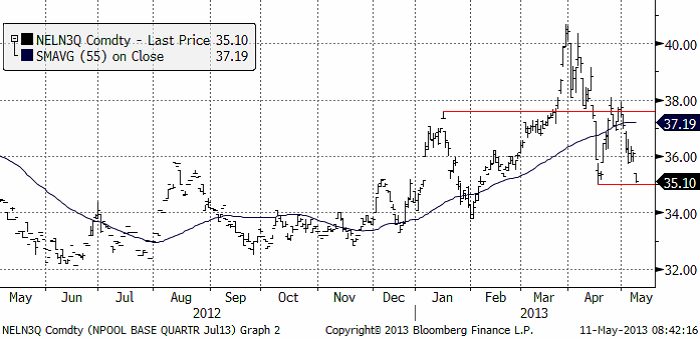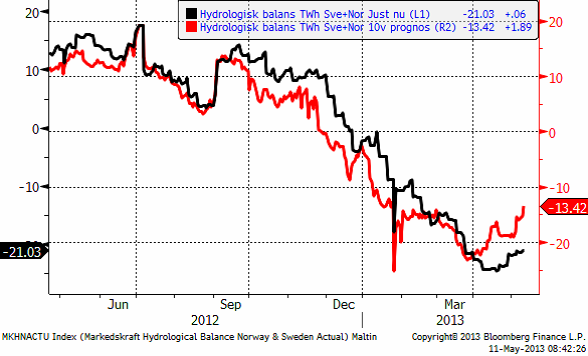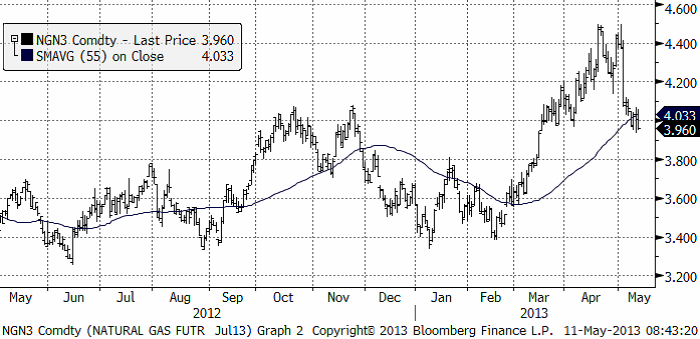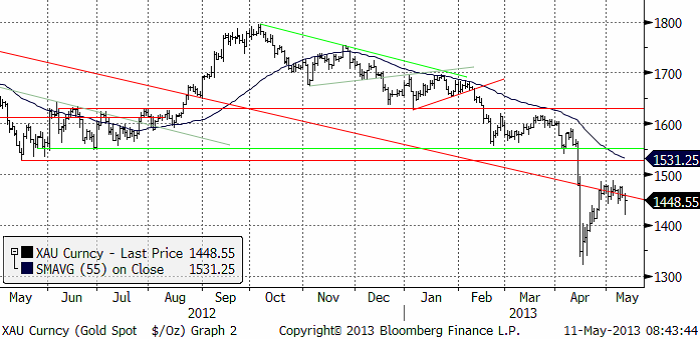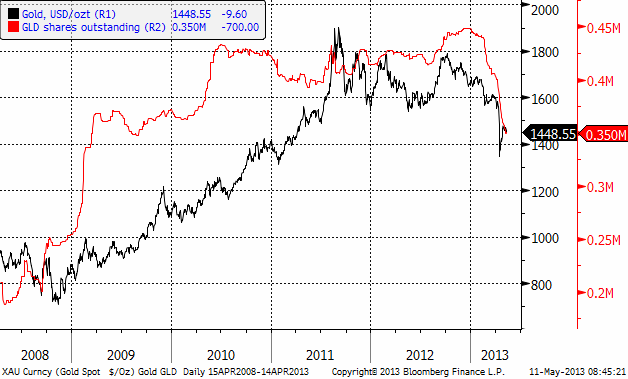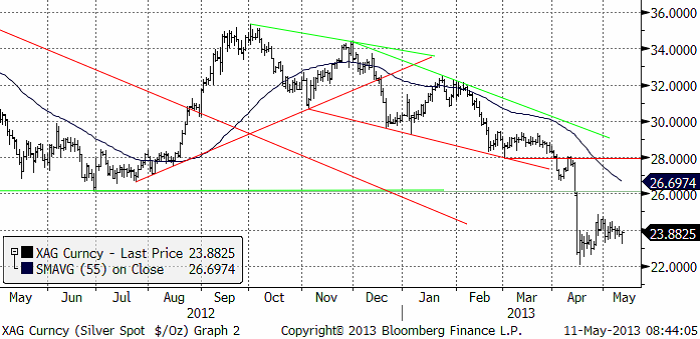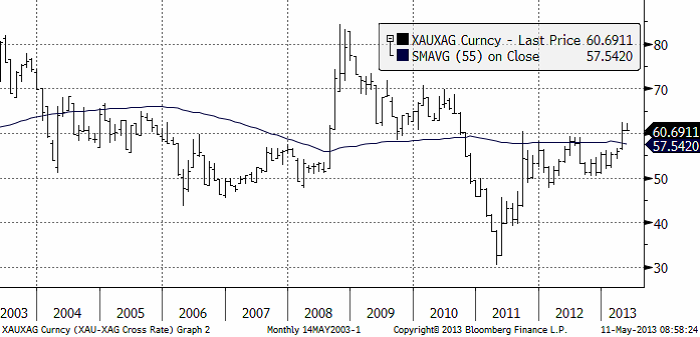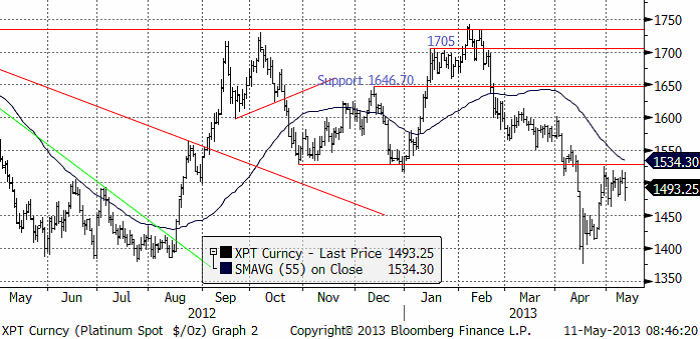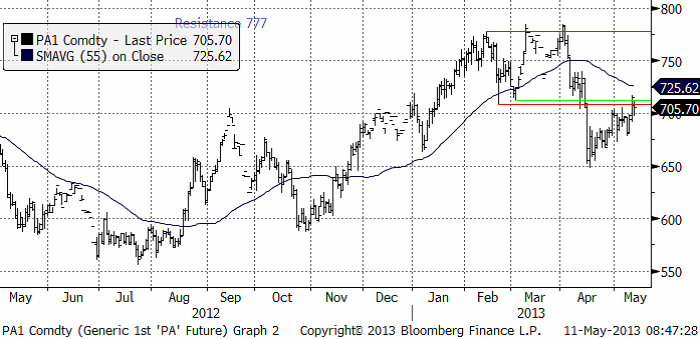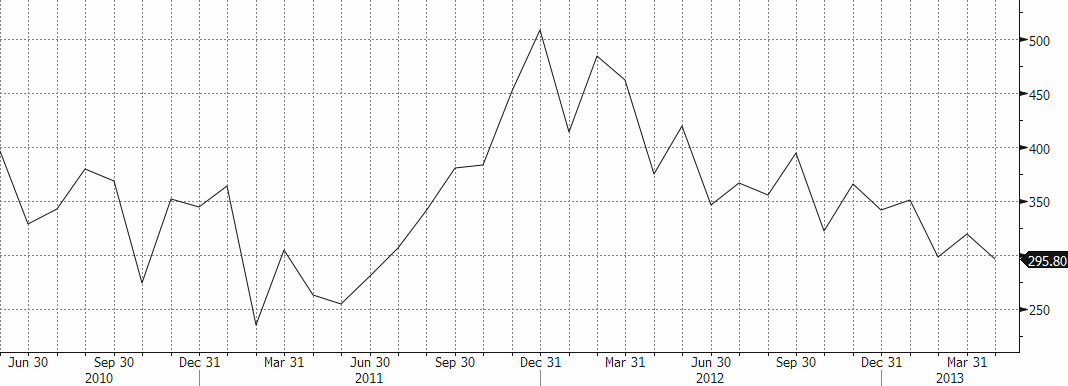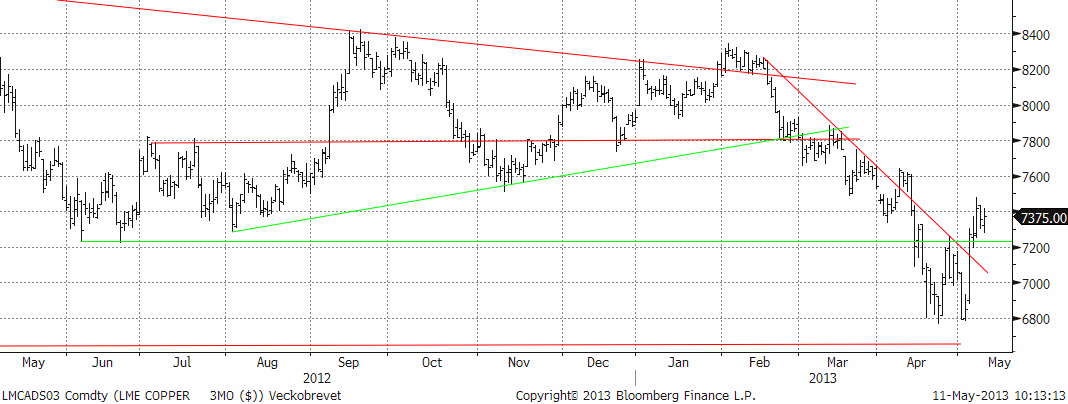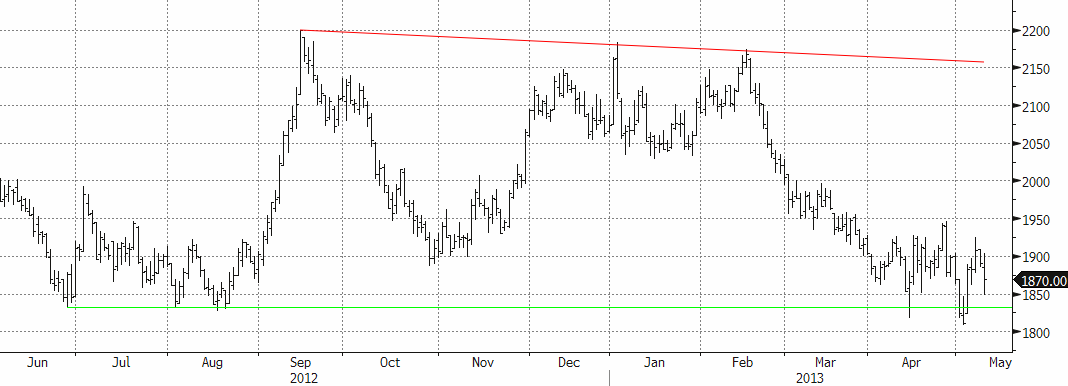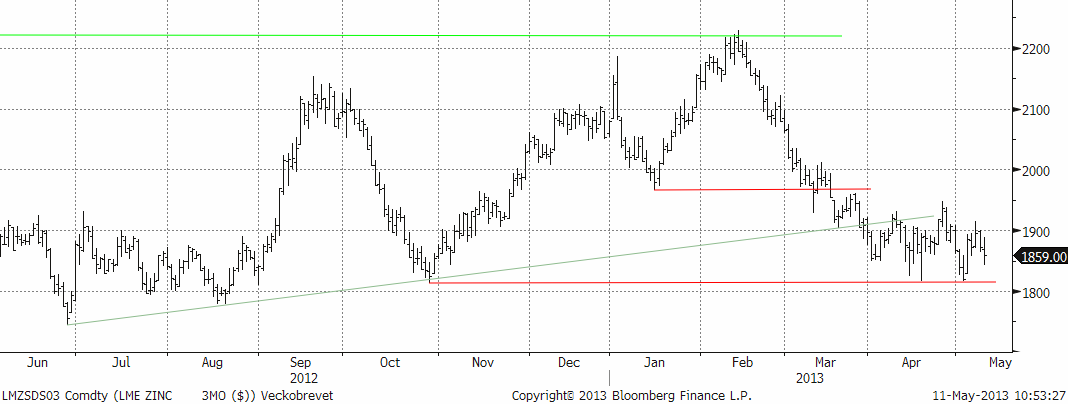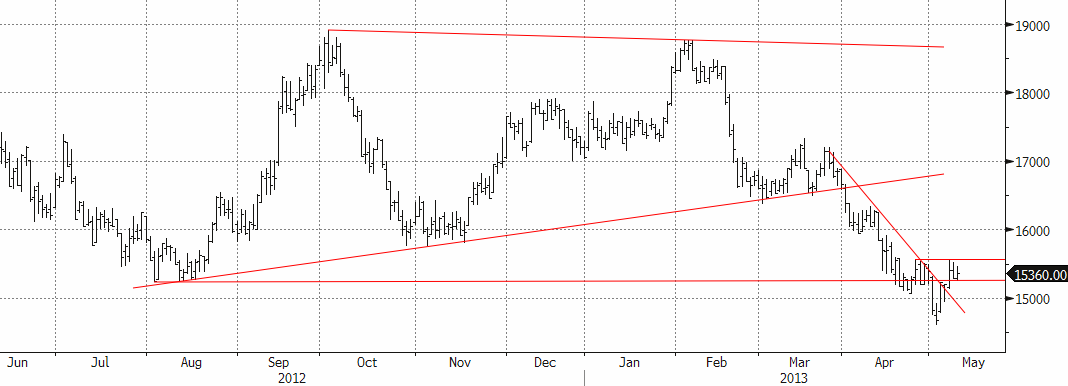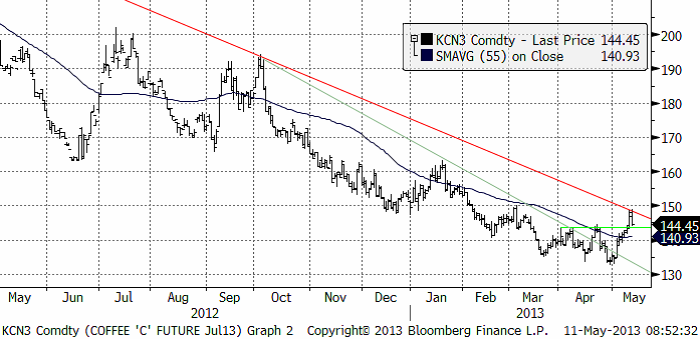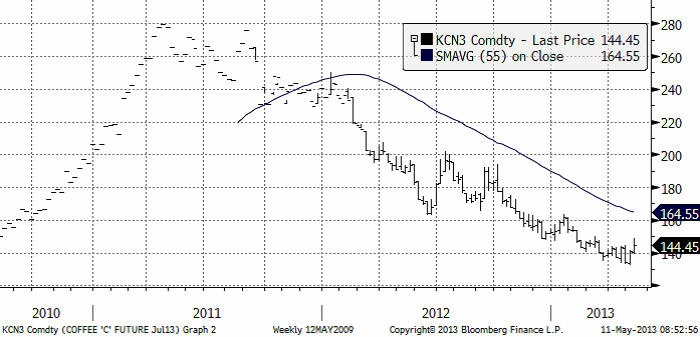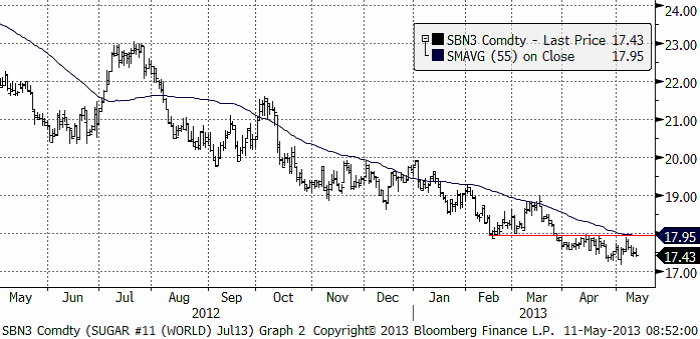Analys
SEB – Råvarukommentarer, 13 maj 2013
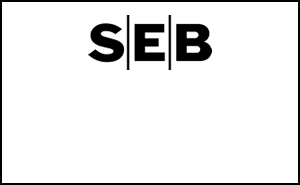
Rekommendationer
*) Avkastningen avser 1:1 råvarucertifikat där de ingår i rekommendationen. I den aktuella tabellen ovan har jag tagit prisförändringen den senaste veckan sedan det förra veckobrevet publicerades.
Inledning
I fredags publicerade det amerikanska jordbruksdepartementet USDA estimat för produktion och utgående lager för 2013/14 för första gången. Produktionen och utgående lager väntas öka mycket för vete, majs och sojabönor. Rapportens siffror motiverar ca 20% lägre pris på var och en av dessa råvaror. Vi har ganska länge haft säljrekommendation, men upprepar rekommendationen att köpa BEAR på vete, majs, sojabönor och raps.
Marknaden för ädelmetaller ser också ut att stå med hälen på trampolinen. Ett prisfall ser alltså oundvikligt ut.
Råolja – Brent
Oljan var upp vid tidigare stödet (nu motståndet) vid 105 dollar. Priset orkade inte igenom och då brukar prisfall följa. Stöd finns vid 100 dollar, men trenden är nedåtriktad i det korta perspektivet. I det långa perspektivet saknas trend för råoljan.
Lagren och lagerförändringarna i USA den senaste rapportveckan ser vi nedan, enligt Department of Energy och American Petroleum Institute.
Nedan ser vi amerikanska råoljelager enligt DOE i tusen fat. Den svarta kurvan är 2012 års lagernivåer vecka för vecka och den lilla röda linjen är 2013 års nivå.
Importen fortsätter att hålla sig under förra årets nivå. Veckans notering var ett nedåthopp.
Vi fortsätter att ligga neutralt för att förhoppningsvis kunna komma in billigare i OLJA S om priset går ner till 100 dollar eller lägre igen.
Elektricitet
Priset ”gappade” ner i fredags, men höll sig över den tekniska stödnivån på 35 euro per MWh. Bryts den finns stöd redan på 34 euro, vilket gör att de köpsugna i marknaden kan känna sig motiverade att riskera 1 euro och köpa på 35 euro. ”Gap” brukar också ”stängas”, vilket i det här fallet skulle innebära en uppgång mot 36 euro. Det är ett svårt läge och vi fortsätter med neutral rekommendation.
Hydrologisk balans har fortsatt att stiga.
Naturgas
Rekylen nedåt i naturgaspriset fortsatte i makligare takt förra veckan. Jag tror att den långsiktiga trenden är uppåtriktad, och tror att det kan vara en bra idé att köpa på den här nivån. Stöd finns på 3.80 och på 3.60. Om man lyckas köpa på de nivåerna har man så klart en bättre position än om man köper på 3.96. Jag tror i vart fall inte att man ska ta ens kortsiktiga positioner för nedgång, utan försöka komma in på den långa sidan.
Guld och Silver
Guldpriset har rekylerat färdigt, tror vi. Vi tror att man ska sälja guld nu, därför att vi tror att det kommer ett kursfall till. Det brukar alltid komma två kursfall med en rekyl emellan, när man haft en så kraftig teknisk säljsignal som vi fick i guld i början på april. När det kursfallet är klart tror jag man kan börja köpa guld igen.
Nedan ser vi kursdiagrammet för silver i dollar per troy ounce.
I diagrammet nedan ser vi priset på guld dividerat med priset på silver. Under 2011 rusade priset på silver på ganska osannolika spekulationer om att en stor bank hade sålt mer ”pappers-silver” än vad som fanns fysiskt att tillgå i världen (till och med). De som trodde på detta har med rätta straffats ganska hårt. I förhållande till guldpriset, har silverpriset halverats. Som vi ser har silverpriset kommit ner till rimliga nivåer i förhållande till guld. De senaste tio årens genomsnitt ligger på ett pris på silver som är 1/60-del av guldprisets.
Jag tror att silverpriset kan gå lite lägre från dagens nivå, ner mot 22 eller 20 dollar. Vi ligger korta guld och silver. Jag tror att det kommer en till vända ner och ligger självklart kvar med köpt position i BEAR GULD X4 S och BEAR SILVER X4 S.
Platina & Palladium
Platinapriset befinner sig fortfarande i en rekylfas uppåt (mot trenden). Priset på platina har tagit sig upp till ett starkt motstånd, markerat av två tidigare bottnar på 1530 dollar. Det är upplagt för nedgång i den fallande trendens riktning. Det ser riktigt bra ut för en kort position och jag rekommenderar köp av BEAR PLATIN X4 S. Jag tror att priset går ner mot 1450, men kanske även till 1400 eller ännu längre ner. Nivån 1400 har tidigare varit en tydlig bottennivå.
Palladium har mycket motigt segat sig upp mot 710 dollar per troy uns. Där finns som vi ser två motståndsnivåer från föregående bottnar. Marknaden reagerar då och då också på 55-dagars glidande medelvärde, som ett motstånd, om det inte bryts. Som vi ser ligger 55-dagars glidande medelvärde bara strax över dagens kursnivå. Ur teknisk synvinkel pekar det mesta: den tröga uppgången från 650 dollar, de två motståndsnivåerna vid 710 dollar och 55-dagars glidande medelvärde för fallande pris härnäst. Jag skulle nog välja att gå in i BEAR PALLAD X4 S i det här läget. Målkursen för den affären är i första hand ner mot 650 dollar och i andra hand ner mot 600 dollar.
Basmetaller
Veckan inleddes med helgstängt i London, vilket innebär begränsad likviditet på många marknader, men synnerhet basmetaller eftersom LME då håller helt stängt. Förra fredagens starka amerikanska statistik gav som vi skrev förra veckan väldigt positiva stängningar. Tisdagens handel fick emellertid inte den förväntade följdrörelsen uppåt. Metallerna låg i startgroparna för ett kortsiktigt rally. Onsdagsmorgonens nyheter om positiva exportsiffror från Kina räckte för att sätta fart. Tekniskt sett nådde priserna i stort sett sina kortsiktiga mål under torsdagen och vi fick se rekyler ner igen på fredagen. Nu står det och väger igen, och är mer oklart inför nästa vecka. Fredagkvällens utveckling (igår) då både olja och metaller steg kraftigt igen, inger visst förtroende. För basmetaller slutar veckan blandat med uppgångar för nickel och koppar på ca 1 %, medan zink och aluminium faller lika mycket.
Koppar
Som vi skrivit tidigare har vi haft kopparn under bevakning för att gå från neutral till köp. Tekniskt sett bedömde vi förutsättningarna som goda för en kortsiktig uppgång, vilket också materialiserades under veckan. Tveksamheten kring den fundamentala situationen kvarstår dock. Veckans handelsstatistik, som överlag mottogs positivt av de finansiella marknaderna, gav inte samma positiva besked för koppar. Kina är nettoimportörer, så statistiken över importen följs noggrant av marknaden. Aprilsiffran faller tillbaka igen till februaris nivå (se graf). Nu anses siffrorna under perioden februari-april i viss mån vara ”störda” av rapporteringen kring det kinesiska nyåret, men det är nu som det säsongsmässigt brukar vända upp igen.
Kopparimporten till Kina (1000-tals ton)
Tekniskt sett fick vi se den förväntade uppgången i veckan. Efter en test av den ”nya” stödnivån strax över $7200 igår fredag, stänger priset kring $7375. Det är för tidigt att tala om en mer långsiktig vändning, men kortsiktigt finns förtutsättningen för ytterligare återhämtning till nivåer kring $7550-7600.
Vi förväntar oss fortsatt hög volatilitet. Vår kortsiktiga bedömning talar för uppsidan och vi rekommenderar därför köp av BULL KOPPAR X2 S eller X4 S.
Aluminium
Den förväntade uppgången tog upp priset till motståndsnivån $1925, men där tog det stopp. Fredagens säljtryck bl.a. på den starkare dollarn, satte mer press på aluminium än på övriga basmetaller. Den kan finnas en förklaring. Japan är en betydande aluminiumimportör och den svaga yenen skapar ett motstånd. Under fredagen bröts den psykologiskt viktiga 100-vallen för usd/yen. Priset på aluminium föll ända ned till stödnivån $1850 (se graf) där den studsar för att stänga på $1870. Vi ser köpintresse framför allt från industriella aktörer som ”täcker in” framtida konsumtion, men också från långsiktiga investerare som bedömer nivåerna som alltför låga för ett fortsatt ökat utbud. Högkostnadsproducenterna, framför allt i Kina, förväntas minska utbudet om priset långvarigt stannar på nuvarande nivåer. Långsiktigt är nivån väldigt intressant för certifikatet ALUMINIUM S (utan hävstång).
Zink
Zinken följde i stort sett övriga metaller under veckan, och får en ganska neutral stängning på veckan. Produktionsstatistik från Kina är lite oroväckande för zinkens fundamentala balans. Smältverksproduktionen ökar i Kina, delvis som en effekt av stort gruvutbud (höjda smältlöner till smältverken). Risken finns att det behövs ännu lägre priser för att påverka gruvutbudet. Risken är att det dröjer innan priset vänder upp på allvar. Vi bedömer ändå zinken som fundamentalt ”billig” ur ett kostnadsperspektiv och nuvarande nivåer är mycket intressanta på lite längre sikt (6-12 månader). I det perspektivet är ZINK S (utan hävstång) att föredra.
Nickel
Efter förra veckans snabba ”dipp” under $15000 till som lägst $14625, har nickel återhämtat sig och balanserar strax över stödnivåerna. Under veckan som gick fick vi den förväntade rekylen uppåt. Motståndet vid $15500 är tydligt (se graf).
Efterfrågeutsikterna är väldigt goda för nickel, där den rostfria- och specialstålproduktionen förväntas öka. Framför allt är det utbyggnaden av olje- och gasproduktion och specialstål till flygindustrin som går bra. Icke desto mindre ”lider” nickelmarknaden av ett överskott. Produktionstekniken av s.k. Nickel Pig Iron i Kina har utvecklats med s.k. Rotary Kiln Electric Furnaces (RKEF) teknik, vilken i genomsnitt sänker hela kostnadskurvan. Samtidigt får högkostnadsproducenterna i gruvledet problem på nuvarande nivåer. Vi har tidigare rapporterat om produktionsneddragningar i Australien, och det förväntas komma mer.
Precis som för koppar är det finansiella kollektivet väldigt ”korta”, d.v.s. det finns ett stort behov att köpa tillbaka tidigare sålda terminskontrakt, som i sig för den volatila metallen nickel, kan skapa utrymme för uppgångar. Effekten av RKEF-tekniken riskerar att flytta ner nivån där utbudsminskningarna verkligen får effekt. Trots det bedömer vi nivåerna som väldigt attraktiva på 6-12 månaders sikt. I det perspektivet är NICKEL S (utan hävstång) att föredra.
Kaffe
Kaffepriset (maj 2013) steg i veckan. Marknaden gjorde ett försök att bryta den övre delen i den trendkanal som priset fallit under i två år. Detta lyckades dock inte den här gången, men som jag har skrivit tidigare ser det ut att finnas köpare som är oroliga för att marknaden har bottnat. När det kommer tecken på styrka i marknaden, tenderar priset att sticka iväg uppåt. Än så länge har det funnits nog med säljare i de lägena för att trycka tillbaka priset, men när det inte längre gör det längre, tyder marknadens beteende på att det kan gå fort uppåt.
Nedan ser vi hur juli-terminen 2013 utvecklat sig prismässigt de tre senaste åren.
Socker
Sockerpriset (september 2013) fortsätter att ligga i fallande pristrend. Ingen skillnad från förra veckan. Socker och kaffe har följt varandra åt under lång tid, men medan kaffet visar lite tecken på trendvändning, ser man inte något alls av det i sockermarknaden. Vi fortsätter med neutral rekommendation.
[box]SEB Veckobrev Veckans råvarukommentar är producerat av SEB Merchant Banking och publiceras i samarbete och med tillstånd på Råvarumarknaden.se[/box]
Disclaimer
The information in this document has been compiled by SEB Merchant Banking, a division within Skandinaviska Enskilda Banken AB (publ) (“SEB”).
Opinions contained in this report represent the bank’s present opinion only and are subject to change without notice. All information contained in this report has been compiled in good faith from sources believed to be reliable. However, no representation or warranty, expressed or implied, is made with respect to the completeness or accuracy of its contents and the information is not to be relied upon as authoritative. Anyone considering taking actions based upon the content of this document is urged to base his or her investment decisions upon such investigations as he or she deems necessary. This document is being provided as information only, and no specific actions are being solicited as a result of it; to the extent permitted by law, no liability whatsoever is accepted for any direct or consequential loss arising from use of this document or its contents.
About SEB
SEB is a public company incorporated in Stockholm, Sweden, with limited liability. It is a participant at major Nordic and other European Regulated Markets and Multilateral Trading Facilities (as well as some non-European equivalent markets) for trading in financial instruments, such as markets operated by NASDAQ OMX, NYSE Euronext, London Stock Exchange, Deutsche Börse, Swiss Exchanges, Turquoise and Chi-X. SEB is authorized and regulated by Finansinspektionen in Sweden; it is authorized and subject to limited regulation by the Financial Services Authority for the conduct of designated investment business in the UK, and is subject to the provisions of relevant regulators in all other jurisdictions where SEB conducts operations. SEB Merchant Banking. All rights reserved.
Analys
Tightening fundamentals – bullish inventories from DOE

The latest weekly report from the US DOE showed a substantial drawdown across key petroleum categories, adding more upside potential to the fundamental picture.

Commercial crude inventories (excl. SPR) fell by 5.8 million barrels, bringing total inventories down to 415.1 million barrels. Now sitting 11% below the five-year seasonal norm and placed in the lowest 2015-2022 range (see picture below).
Product inventories also tightened further last week. Gasoline inventories declined by 2.1 million barrels, with reductions seen in both finished gasoline and blending components. Current gasoline levels are about 3% below the five-year average for this time of year.
Among products, the most notable move came in diesel, where inventories dropped by almost 4.1 million barrels, deepening the deficit to around 20% below seasonal norms – continuing to underscore the persistent supply tightness in diesel markets.
The only area of inventory growth was in propane/propylene, which posted a significant 5.1-million-barrel build and now stands 9% above the five-year average.
Total commercial petroleum inventories (crude plus refined products) declined by 4.2 million barrels on the week, reinforcing the overall tightening of US crude and products.


Analys
Bombs to ”ceasefire” in hours – Brent below $70

A classic case of “buy the rumor, sell the news” played out in oil markets, as Brent crude has dropped sharply – down nearly USD 10 per barrel since yesterday evening – following Iran’s retaliatory strike on a U.S. air base in Qatar. The immediate reaction was: “That was it?” The strike followed a carefully calibrated, non-escalatory playbook, avoiding direct threats to energy infrastructure or disruption of shipping through the Strait of Hormuz – thus calming worst-case fears.

After Monday morning’s sharp spike to USD 81.4 per barrel, triggered by the U.S. bombing of Iranian nuclear facilities, oil prices drifted sideways in anticipation of a potential Iranian response. That response came with advance warning and caused limited physical damage. Early this morning, both the U.S. President and Iranian state media announced a ceasefire, effectively placing a lid on the immediate conflict risk – at least for now.
As a result, Brent crude has now fallen by a total of USD 12 from Monday’s peak, currently trading around USD 69 per barrel.
Looking beyond geopolitics, the market will now shift its focus to the upcoming OPEC+ meeting in early July. Saudi Arabia’s decision to increase output earlier this year – despite falling prices – has drawn renewed attention considering recent developments. Some suggest this was a response to U.S. pressure to offset potential Iranian supply losses.
However, consensus is that the move was driven more by internal OPEC+ dynamics. After years of curbing production to support prices, Riyadh had grown frustrated with quota-busting by several members (notably Kazakhstan). With Saudi Arabia cutting up to 2 million barrels per day – roughly 2% of global supply – returns were diminishing, and the risk of losing market share was rising. The production increase is widely seen as an effort to reassert leadership and restore discipline within the group.
That said, the FT recently stated that, the Saudis remain wary of past missteps. In 2018, Riyadh ramped up output at Trump’s request ahead of Iran sanctions, only to see prices collapse when the U.S. granted broad waivers – triggering oversupply. Officials have reportedly made it clear they don’t intend to repeat that mistake.
The recent visit by President Trump to Saudi Arabia, which included agreements on AI, defense, and nuclear cooperation, suggests a broader strategic alignment. This has fueled speculation about a quiet “pump-for-politics” deal behind recent production moves.
Looking ahead, oil prices have now retraced the entire rally sparked by the June 13 Israel–Iran escalation. This retreat provides more political and policy space for both the U.S. and Saudi Arabia. Specifically, it makes it easier for Riyadh to scale back its three recent production hikes of 411,000 barrels each, potentially returning to more moderate increases of 137,000 barrels for August and September.
In short: with no major loss of Iranian supply to the market, OPEC+ – led by Saudi Arabia – no longer needs to compensate for a disruption that hasn’t materialized, especially not to please the U.S. at the cost of its own market strategy. As the Saudis themselves have signaled, they are unlikely to repeat previous mistakes.
Conclusion: With Brent now in the high USD 60s, buying oil looks fundamentally justified. The geopolitical premium has deflated, but tensions between Israel and Iran remain unresolved – and the risk of missteps and renewed escalation still lingers. In fact, even this morning, reports have emerged of renewed missile fire despite the declared “truce.” The path forward may be calmer – but it is far from stable.
Analys
A muted price reaction. Market looks relaxed, but it is still on edge waiting for what Iran will do

Brent crossed the 80-line this morning but quickly fell back assigning limited probability for Iran choosing to close the Strait of Hormuz. Brent traded in a range of USD 70.56 – 79.04/b last week as the market fluctuated between ”Iran wants a deal” and ”US is about to attack Iran”. At the end of the week though, Donald Trump managed to convince markets (and probably also Iran) that he would make a decision within two weeks. I.e. no imminent attack. Previously when when he has talked about ”making a decision within two weeks” he has often ended up doing nothing in the end. The oil market relaxed as a result and the week ended at USD 77.01/b which is just USD 6/b above the year to date average of USD 71/b.

Brent jumped to USD 81.4/b this morning, the highest since mid-January, but then quickly fell back to a current price of USD 78.2/b which is only up 1.5% versus the close on Friday. As such the market is pricing a fairly low probability that Iran will actually close the Strait of Hormuz. Probably because it will hurt Iranian oil exports as well as the global oil market.
It was however all smoke and mirrors. Deception. The US attacked Iran on Saturday. The attack involved 125 warplanes, submarines and surface warships and 14 bunker buster bombs were dropped on Iranian nuclear sites including Fordow, Natanz and Isfahan. In response the Iranian Parliament voted in support of closing the Strait of Hormuz where some 17 mb of crude and products is transported to the global market every day plus significant volumes of LNG. This is however merely an advise to the Supreme leader Ayatollah Ali Khamenei and the Supreme National Security Council which sits with the final and actual decision.
No supply of oil is lost yet. It is about the risk of Iran closing the Strait of Hormuz or not. So far not a single drop of oil supply has been lost to the global market. The price at the moment is all about the assessed risk of loss of supply. Will Iran choose to choke of the Strait of Hormuz or not? That is the big question. It would be painful for US consumers, for Donald Trump’s voter base, for the global economy but also for Iran and its population which relies on oil exports and income from selling oil out of that Strait as well. As such it is not a no-brainer choice for Iran to close the Strait for oil exports. And looking at the il price this morning it is clear that the oil market doesn’t assign a very high probability of it happening. It is however probably well within the capability of Iran to close the Strait off with rockets, mines, air-drones and possibly sea-drones. Just look at how Ukraine has been able to control and damage the Russian Black Sea fleet.
What to do about the highly enriched uranium which has gone missing? While the US and Israel can celebrate their destruction of Iranian nuclear facilities they are also scratching their heads over what to do with the lost Iranian nuclear material. Iran had 408 kg of highly enriched uranium (IAEA). Almost weapons grade. Enough for some 10 nuclear warheads. It seems to have been transported out of Fordow before the attack this weekend.
The market is still on edge. USD 80-something/b seems sensible while we wait. The oil market reaction to this weekend’s events is very muted so far. The market is still on edge awaiting what Iran will do. Because Iran will do something. But what and when? An oil price of 80-something seems like a sensible level until something do happen.
-

 Nyheter4 veckor sedan
Nyheter4 veckor sedanMahvie Minerals växlar spår – satsar fullt ut på guld
-

 Analys4 veckor sedan
Analys4 veckor sedanA muted price reaction. Market looks relaxed, but it is still on edge waiting for what Iran will do
-

 Nyheter3 veckor sedan
Nyheter3 veckor sedanJonas Lindvall är tillbaka med ett nytt oljebolag, Perthro, som ska börsnoteras
-

 Nyheter3 veckor sedan
Nyheter3 veckor sedanOljan, guldet och marknadens oroande tystnad
-

 Nyheter3 veckor sedan
Nyheter3 veckor sedanDomstolen ger klartecken till Lappland Guldprospektering
-

 Analys3 veckor sedan
Analys3 veckor sedanTightening fundamentals – bullish inventories from DOE
-

 Nyheter2 veckor sedan
Nyheter2 veckor sedanRyska staten siktar på att konfiskera en av landets största guldproducenter
-
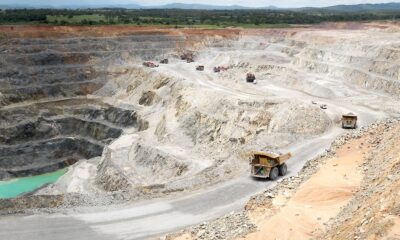
 Nyheter2 veckor sedan
Nyheter2 veckor sedanLundin Mining ska bli en av de tio största kopparproducenterna i världen



